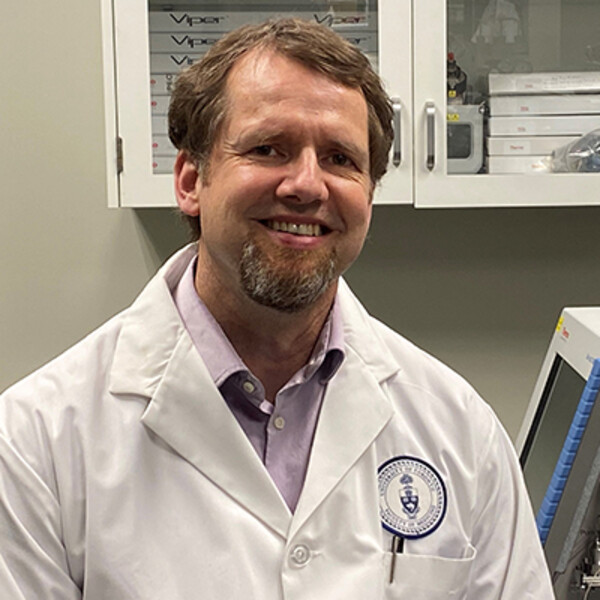From One Health to Prion diseases: LMP research in Fall CIHR funding rounds

In the latest Canadian Institutes of Health Research (CIHR) round of Fall 2022, eight projects involving LMP-appointed faculty have been funded.
Congratulations to all the funded Principle Investigators and their collaborators!
Read about each funded project below.

Dr. Samira Mubareka
Based at Sunnybrook Research Institute
Project: A collaborative, One Health approach to zoonotic virus detection and risk assessment at the wildlife-human nexus
Abstract: Many infectious diseases are zoonotic in origin. These pathogens may spill over into other species and cause disease. Zoonotic viral pathogens include influenza virus, Ebola virus, Zika virus, severe acute respiratory syndrome coronavirus-2 (SARS-CoV-2) and Middle East respiratory syndrome coronavirus (MERS-CoV).
The complex interactions between human and wildlife hosts and the virus warrants a One Health approach, whereby a multi-disciplinary lens is applied to address complex challenges.
Recent outbreaks of highly pathogenic avian influenza (HPAI) in Newfoundland and Nova Scotia underscores the need to apply a global lens to emerging pathogen surveillance/control. This virus has been circulating in Europe, Africa and Asia. Globally, there has been an inordinate amount of HPAI activity. Currently, there is no active surveillance program for avian influenza in countries such as Ghana, despite the importance of domestic poultry holders from economic and food security standpoints, and multiple outbreaks. These events constitute early warnings that merit immediate, coordinated attention, and provide a clear opportunity to enhance pandemic preparedness.
Global biosecurity is highly dependent on early emerging pathogen detection and risk determination. Inter-jurisdictional collaboration is essential to human and animal health, food security and ecological resilience. We anticipate ongoing emergence of viral zoonoses over the coming decades.
We propose to galvanize a multi-disciplinary team poised to respond to novel pathogen emergence using a One Health approach around the clear and present danger posed by HPAI. Our expertise spans scales of study (from molecular to populations), hosts (mammalian and avian) and jurisdictions (national, international). By applying unique skill sets in biocontainment, virology, field and clinical epidemiology and human and animal health, we will address capacity gaps in emerging pathogen detection and risk determination.
- Collaborators: Berhane, Yohannes; Côté, Marceline; Dikeakos, Dimitrios J; Finzi, Andrés; Lee, Nelson L; Miller, Matthew S; Sharif, Shayan

Dr. Gerold Schmitt-Ulms
Based at the Tanz Centre for Neurogenerative Disease
Project: Targeting sodium potassium pumps for the treatment of prion diseases
Abstract: Prion diseases, such as Creutzfeldt-Jakob Disease (CJD) and Bovine Spongiform Encephalopathy (BSE), also known as Mad Cow Disease, are fatal neurodegenerative diseases that afflict humans and animals. This research aims to advance our understanding of these diseases and discover a treatment for them.
We know that we could extend prion disease survival if we were able to reduce the levels of a particular protein, the cellular prion protein (PrPC). We also know that it would be safe to do so because individuals whose cells produce half the levels of PrPC are not impacted in their health, and animals who produce no PrPC are similarly unaffected. We recently discovered that PrPC binds to sodium-potassium ATPases (NKAs), specific transport proteins that pump charged potassium and sodium metals in and out of cells. We hypothesized that targeting NKAs with their natural inhibitors, cardiac glycosides (CGs), may cause cells to internalize and degrade NKAs, and that PrPC residing next to NKAs may get co-degraded. In preparation of this proposal, we have validated this idea in several relevant human cell models. We also have developed a synthetic CG that has favorable characteristics for brain applications. The current proposal is informed by these data and will address in independent, yet synergistic, aims the question: Can treatment with CGs reduce the levels of PrPC and extend prion disease survival?
The project builds on substantial unpublished data that tie NKAs to prion diseases. In collaboration with an international team, we will reveal in detail the mechanism of action through which CGs reduce PrPC levels and provide proof-of-principle pre-clinical data for the treatment of prion diseases using this novel treatment modality. Moreover, the ability to suppress PrPC levels may translate into a treatment of Alzheimer's disease (AD), because PrPC is widely believed to be a critical player in a cascade of events that leads to the demise of brain cells in AD.

Dr. Ming-Sound Tsao
Based at Toronto General Hospital, University Health Network (UHN)
Project: Predictive biomarkers for adjuvant immune checkpoint inhibitor therapy in non-small cell lung cancer
Abstract: Lung cancer is the leading cause of cancer death worldwide, with only 16% of patients alive at 5 years. Non-small cell lung cancer (NSCLC) makes up at least 80% lung cancers. For patients diagnosed with late-stage NSCLC without driver mutations that can be treated by targeted therapies, immunotherapy, with or without chemotherapy, is commonly recommended.
Immunotherapy can significantly improve survival, and quality of life, compared to chemotherapy alone. However, not all patients benefit from immunotherapy, and markers measured in the tumour can identify patients who have a greater chance of benefit. In contrast, patients diagnosed with early-stage NSCLC are treated mainly by surgery, as it offers a chance of cure. However, in up to 50% of these patients, the lung cancer will still recur after complete surgical removal. With the success of immunotherapy in patients with late-stage disease, several clinical trials are ongoing in early-stage NSCLC, to assess whether immunotherapy given after surgery will decrease the chance of the cancer recurring and improve the chance of cure. BR.31 is one such trial, involving patients from 19 countries worldwide, and led by the Canadian Cancer Trials Group in Kingston, Ontario. Importantly, a piece of NSCLC tumor removed at the time of surgery, has been collected from each BR.31 patient.
The goal of this research proposal is to conduct studies on these tumour samples, and identify biomarkers that can predict benefit from immunotherapy in early-stage NSCLC. The results may further enhance the personalization and precision of immunotherapy in lung cancer patients.
- Collaborators: Goss, Glenwood D (Principal investigator); Bradbury, Penelope; Cottrell, Tricia; Ding, Keyue; O'Callaghan, Christopher J; Pugh, Trevor J

Dr. Daniel Winer
Based at Toronto General Hospital, University Health Network (UHN)
Project: Mechanisms of B cell mediated inflammation during aging
Abstract: Aging is associated with an increase in most chronic diseases. With an increasingly elderly global population, aging is creating an enormous and growing health, social, and economic burden. In recent years, research has identified several prime molecular and cellular causes of aging, with one of these causes being a low level of inflammation within the body. This persistent inflammation with age is also known as "inflammaging" and is associated with age-related reduced immune cell robustness, called "immunosenescence". Interestingly, part of the reason for a weakened immune response with age is that the T cells of the adaptive immune system lose their diversity, though the reasons why are not understood. Moreover, both T and B cells of the adaptive immune system become pushed into a state of increased basal inflammation, which both contributes to their dysfunction. These T and B cells typically accumulate inside old tissues to cause disease, though the factors that drive them into dysfunctional inflammatory states are still not entirely known.
In this proposal we aim to look at why immune cells, like B cells, become more inflammatory with age and what they do to other immune cells, and to the tissues in which they build up. Interestingly, we found that one hormone of aging, insulin, can recapitulate many features of aging in B cells and the adaptive immune system in mice across their lifespan. We will focus first on understanding if, and how B cells contribute to immunosenescence and in driving whole body features of aging. Next, we will look into how insulin impacts B cell metabolism, and look at mitochondrial function in B cells as a cause of aging. Finally, we will identify what B cells are recognizing during aging to better understand B cell changes with age. This work will provide new insight into how the immune system ages with relevance to the numerous chronic diseases of aging.
- Collaborators: Ohashi, Pamela S; Winer, Shawn M
Cross-appointed LMP faculty

Dr. Razqallah Hakem
Cross-appointed from the Department of Medical Biophysics
Project: Targeting transcription-replication conflicts as vulnerabilities in BRCA1 mutant and homologous recombination-deficient breast and ovarian cancers
Abstract: Breast and ovarian cancers can be very aggressive and associate with poor prognosis. In addition, patients with these cancer types tend to develop therapy resistance. Therefore, there is an urgent need to identify novel targets to improve the therapy and the killing of these cancers.
Building on our extensive expertise studying breast and ovarian cancers, our continued focus to identify Achilles heel of cancers, and with our team of national and international collaborators (scientists, clinicians, and pathologists) we aim to identify novel targets that kill breast and ovarian aggressive cancer cells. Based on our strong data, we believe that we will identify novel approaches that will allow us to deregulate the machineries of cancer cells and thus promote their death. Completion of our studies will have great impacts on our understanding of novel mechanisms that kill aggressive breast and ovarian cancers. The knowledge obtained from our proposed studies is critical for the development of more effective cancer therapies.
Dr. Robert Hamilton
Cross-appointed from the Department of Paediatrics
Project: Determining the fetal conduction target proteins of autoantibodies in congenital heart block: developing a sensitive and specific biomarker of pregnancies at risk
Abstract: Congenital heart block (CHB) is a disorder that affects the heart of babies. CHB develops in the fetus of mothers who have autoimmune disease (like having an allergy to your own body) at 16 to 20 weeks of pregnancy. The specific autoimmune diseases involved are lupus and Sjögren's syndrome, although many mothers do not know they have these diseases until their baby is found to have CHB.
Babies with CHB have heart conduction cells that cannot properly transmit the electrical signals for the heart to beat normally, resulting in a slow heart rate, heart failure and sometimes death, even before birth. Autoimmunity is caused by antibodies in the blood that attack certain proteins in your own body. We know that in the mother the antibodies target proteins called Ro. These anti-Ro antibodies are almost always present in the mother when the baby has CHB. However, only 2% of mothers with anti-Ro antibodies have a baby with CHB. This means there are other antibodies from the mother that target proteins in the baby's heart that have yet to be found. The identification of these antibodies would allow us to accurately test for those pregnancies that will be affected. We have pioneered a way to find the mother's antibodies and pinpoint which proteins in the baby's heart are targeted. So far, we discovered that by the time of birth, thirty different antibodies against the heart are present. By looking at samples earlier in pregnancies, we have narrowed this to four unique antibodies that predict CHB development, one of which likely causes the disease.
In this project, we will identify which antibodies appear first, and confirm that they accurately predict disease using a combination of samples we have already obtained from prior patients and new samples we will collect during the study. Our study is made possible by the collaboration of investigators from Canada (Toronto, Montreal), Sweden, France and Italy, and the patient groups that support these programs.
- Collaborators: Jaeggi, Edgar T; Protze, Stephanie I; Vinet, Evelyne

Dr. Laura Rosella
Cross-appointed from the Dalla Lana School of Public Health
Project: Setting the Balance of Care for Older Adults at Risk of Hospitalization with a Discharge Delay
Abstract: Each year in Canada there are over 3 million acute care hospital stays. Of these hospital stays, about 1/5 people end up getting stuck because the next care setting they need (such as homecare or long-term care) is not available. Most of the people who end up getting stuck are older adults and they are at risk of getting sicker and more frail as they wait (because they typically receive little or no therapy while waiting). A lot of research has focused on how to provide better care when older adults are in hospital, but there has been less focus on understanding, for whom, these hospitalizations could be avoided all together.
Our team of researchers, health and social care providers, patients, families and decision makers are working together to understand how older adults can receive supports in the community to avoid going into hospital in the first place as well as avoid harm and decline if they do go into hospital.
Our project consists of 3 steps.
First, we will use large databases to take a closer look at the characteristics of older adults who are at risk of hospitalization with a delay in discharge and organize them into groups based on their personal, social and health characteristics and utilization patterns.
Second, we will present these groups to people in the community (patients, their family members and care providers) and co-create vignettes (short stories, which build on the quantitative data, helping to personalize them). Third, we will design care packages for each persona.
Finally, we will bring everyone together in a meeting to review findings and talk about the barriers and enablers to implementing the service packages. At the end of the study we will 1) understand what older adults at risk of hospital care with a discharge delay look like 2) understand what needs to happen in the community and the hospital for them to avoid a discharge delay and 3) the challenges that need to be overcome if a shift from hospital to community could occur.
- Collaborators, Principal Investigators: Kuluski, Kerry H; Edelstein, Beatrise; Fernandes, Liane; Guilcher, Sara J; Zargoush, Manaf
- Co-investigators: Backo-Shannon, Mira; Mansfield, Elizabeth A; Sud, Abhimanyu; Tang, Terence

Dr. Darren Yuen
Cross-appointed from the Department of Medicine
Project: Stage-specific treatment of human non-alcoholic fatty liver disease: elucidating the precise mechanisms of actions of glucagon-like peptide-1 receptor agonists and novel anti-fibrosis molecules
Abstract: Non-alcoholic Fatty Liver Disease (NAFLD) is present in 30% of Canadians, reaching >70% in those with diabetes and obesity. Many progress from reversible stages of liver fat accumulation to inflammation (non-alcoholic steatohepatitis-NASH) and fibrosis; to irreversible stages of cirrhosis and cancer.
No medicines are yet approved for NAFLD but the most promising are long-acting glucagon-like peptide-1 receptor agonists (GLP-1-RA) which reduced NASH activity in most patients but did not reduce fibrosis, the primary determinant of long-term survival. There is thus great need for anti-fibrosis drugs, which we've just identified to be YAP/TAZ NUAK inhibitors (NUAK-i). The major problems with previous studies are: 1) inability to dissect the different components of this complex disease including mitochondria dysfunction, toxic fat accumulation, inflammation and fibrosis; and elucidate the specific mechanisms each drug actually works on each disease component; and 2) directly test drugs on the different stages of human NAFLD livers whereby each stage likely requires specific drug combinations, recognizing that mouse models may not completely mimic human NAFLD nor accurately predict clinical response to treatment.
We surmounted these problems by: 1) developing thin liver slices assays that independently assess fat accumulation (Aim 1), mitochondria function & survival (Aim 2), and fibrosis (Aim 3); and 2) obtaining fresh liver samples from patients undergoing bariatric surgery that span the reversible stages of NAFLD (normal, steatosis, NASH) and various stages of fibrosis. This provides a unique opportunity to test our hypothesis that GLP-1RA and NUAK-i can block or reverse each disease component of NAFLD. This work will: 1) unequivocally show the specific cellular events matched to disease genes and NAFLD stage rescued by GLP-1-RAs and NUAK-i; and 2) provide a precision medicine approach to treat each NAFLD stage with insights directly translatable to clinical trials.
- Collaborators: Gaisano, Herbert Y (Principal investigator); Allard, Johane P



